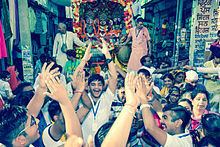Founded 25 September 2014 Place Nabha, Punjab, India | Abolished By ISKCON | |
 | ||
Founded By Committee Mandir Thakur Shri Saty Narayan Ji Organizer Committee Mandir Thakur Shri Saty Narayan Ji | ||
Punjab darpan 11 09 2016 bhagwan jagan nath rath yatra nabha
Ratha Yatra (Oriya: ରଥଯାତ୍ରା or Ratha Jatra or Chariot Festival) is a Hindu festival associated with the god Jagannath held at Mandir Thakur Shri Saty Narayan Ji in the Nabha City, state of Punjab, India. This annual festival is celebrated in the month of August or September. The festival commemorates Jagannath's annual visit to Nabha city.
Contents
- Punjab darpan 11 09 2016 bhagwan jagan nath rath yatra nabha
- Description
- The Chariot
- Examples
- References
As part of Ratha Yatra, the deities of Jagannath, Balabhadra and Subhadra are taken out in a procession to Devi Chowk. Then the deities or Ratha Yatra starts and the Parikrama of the Nabha city. The return journey of Puri Jagannath Ratha Jatra is known as Bahuda Jatra.
Three richly decorated chariots, resembling temple structures, are pulled through the streets of Puri called Badadanda. This commemorates the annual journey of Lord Jagannath, Lord Balabhadra, and their sister Subhadra to their aunt's temple, the Gundicha Temple which is situated at a distance of 2 km from their temple. This is the only day when devotees who are not allowed in the temple premises, such as non-Hindus and foreigners, can get their glimpse of the deities. During the festival, devotees from all over the world go to Puri with an earnest desire to help pull the Lords' chariots with the help of other priests pulling the chariots with ropes. They consider this a pious deed and risk their lives in the huge crowd. The huge processions accompanying the chariots play devotional songs with drums, tambourines, trumpets etc. Children line the streets through which the chariot will pass and add to the mass chorus. The Ratha carts themselves are some approximately 45 feet (14 m) high and are pulled by the thousands of pilgrims who turn up for the event; the chariots are built anew each year only from a particular type of tree. Millions of devotees congregate at Puri for this annual event from all over the country and abroad. It is also broadcast live on many Indian, foreign television channels as well as many of the websites telecast jagannath ratha yatra live.
Description
Ratha Jatra, the Festival of Chariot: Chariots of Shri Jagannath is celebrated every year at Nabha, the temple town in Punjab. The presiding deities of the Lord Jagannath, Lord Balabhadra and Goddess Subhadra, with the celestial wheel (Sudarshana Chakra) are taken out from the temple precincts in an elaborate ritual procession to their chariot. The huge, colourfully decorated chariot is drawn by multitude of devotees on the Devi Chowk, the grand avenue and the main place of the Nabha City. After the ratha yatra deities return to their abode.
The Chariot
The chariot of Balarama, Subhadra and Jagannatha is newly constructed every year with wood of specified trees like phassi, dhausa, etc. They are customarily brought from the ex-princely state of Dasapalla by a specialist team of carpenters who have hereditary rights and privileges for the same. The logs are traditionally set afloat as rafts in the river Mahanadi. These are collected near Puri and then transported by road.
The chariot is decorated as per the unique scheme prescribed and followed for centuries stand on the Santoshi Mata Mandir, Duladdi Gate the Grand Avenue. Covered with bright canopies made of stripes of red cloth and combined with those of black, yellow and blue colors, the huge chariot is lined across the wide avenue in front of the majestic temple close to its eastern entrance.
Lord Jagannatha's chariot is called Nandighosa. It is decked with a cover made of red and yellow cloth. Lord Jagannatha is identified with Krushna, who is also known as Pitambara, the one attired in golden yellow robes and hence the distinguishing yellow stripes on the canopy of this chariot.
The chariot of Lord Balarama, called the Taladhwaja, is the one with the Palm Tree on its flag.
The chariot of Subhadra, known as Dwarpadalana, literally "trampler of pride,” This chariot is decked with a covering of red and black cloth – black being traditionally associated with Shakti and the Mother Goddess.
Around the chariot are nine Parsva devatas, painted wooden images representing different deities on the chariots' sides. Chariots is attached to four horses. These are of different colours – dark ones for Balarama, white ones for Jagannatha, and red ones for Subhadra. Each chariot has a charioteer called Sarathi. Descriptions of the Chariots
